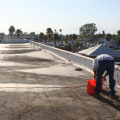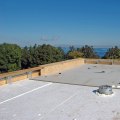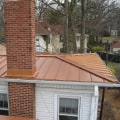When it comes to eco-friendly roofing options, EPDM rubber is often hailed as the most sustainable choice. But what makes this material so special? In this article, we'll explore the benefits of EPDM rubber and other green roofing materials, so you can make an informed decision about your roofing project. EPDM (or ethylene propylene diene monomer) is a widely used material for flat roofs. It's known for its durability, longevity and for being environmentally friendly. It's made from materials such as aluminum, copper, galvanized steel and tin, making it a fully recyclable roof design. Metal roofs are also a smart and eco-friendly option.
They offer an incredibly durable and long-lasting roof design, while also reducing the temperature in your home thanks to their reflective nature. Re-roofing your home can be one of the most expensive renovation projects you can undertake, so it's important to choose a durable and energy efficient material. When it comes to sustainability, not all roofing materials qualify as truly sustainable. To be considered eco-friendly, a roofing material must be produced without exhausting or permanently damaging its resources. It must also not cause significant or irreparable damage to the land during its production.
According to these definitions, any roofing material that uses fossil fuels or materials extracted from mines is not sustainable.
Metal Roofs
Producing metal roofs is energy intensive, but they are attractive and durable, and often contain a high content of recycled material or are easily recyclable at the end of their useful life. Metal roofs may reflect some heat to reduce heat gain, but they must be properly insulated because the metal is highly conductive to heat. The most common metal roofing materials are steel and aluminum.Slate Roofs
Slate is beautiful and incredibly durable (a slate roof can last longer than a house), but it's also very expensive and heavy. Significant resources are needed to extract, process and transport it, making stone mining an unsustainable practice.In addition, the weight of slate roofs requires an additional roof structure.
Wooden Shingles
Wooden shingles and shakes are arguably the most sustainable roofing materials, as wood is a renewable resource. Of course, that means that the roof comes from sustainably harvested sources. The production of milkshakes and shingles requires quite a bit of energy and are only moderately durable.Asphalt ShinglesTechnically referred to as composite shingles, standard asphalt shingles are moderately durable and can offer good thermal reflectivity depending on the design and color of the shingle. They are made with paper and minerals, as well as fiberglass, tar and other petroleum products.Some companies and municipalities use discarded asphalt shingles, but for the most part they are not extensively recycled or biodegradable.
Concrete Shingles
Both concrete shingles and fiber cement shingles are made from Portland cement, which is energy intensive and generates a significant amount of CO2 (a greenhouse gas) emissions. However, these roofing materials are extremely durable. Concrete shingles are heavy and may require an additional roof structure.Green RoofsAlso known as living roofs, green roofs are flat or low-sloped roofs that are partially or completely covered by vegetation. They offer several benefits including absorbing rainwater to prevent runoff and providing insulation to your home.On the downside, green roofs rely on a high-strength rubber membrane to waterproof the roof which is not a sustainable resource.
The Benefits of EPDM Rubber
EPDM rubber is often hailed as the most environmentally friendly roofing system due to its durability and longevity. It's made from recycled rubber tires which makes it highly recyclable at the end of its useful life. It's also lightweight which means it doesn't require an additional roof structure for support. EPDM rubber is also energy efficient as it reflects the sun's rays instead of absorbing heat. In addition, it allows for additional layers of insulation which promotes greater energy conservation with good ventilation.The Bottom Line
When it comes to eco-friendly flat roofing options, EPDM rubber is often hailed as one of the best choices due to its durability, longevity and energy efficiency.Metal roofs are also a great option as they offer an incredibly durable design while reducing the temperature in your home thanks to their reflective nature.



